The Fox dates from the 18th century, when it was situated further down Denmark Hill and known as Little Denmark Halls. Later, it was called The Fox Under Hill, replaced in 1874, but destroyed during World War II. It was then rebuilt up Denmark Hill and is now a Wetherspoon pub.
Framed drawings and text about The Fox on the Hill.
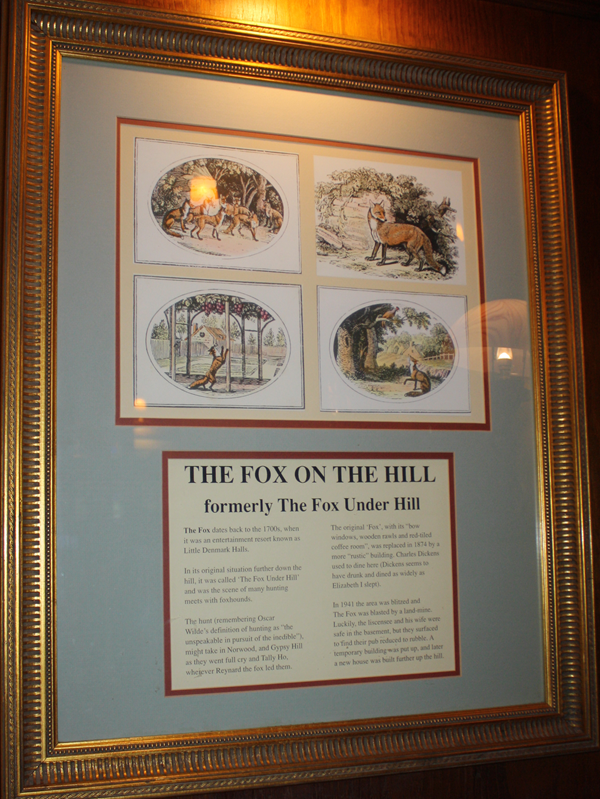
The text reads: The Fox dates back to the 1700s, when it was an entertainment resort known as Little Denmark halls.
In its original situation further down the hill, it was called ‘The Fox Under Hill’ and was the scene of many hunting meets with foxhounds.
The hunt (remembering Oscar Wilde’s definition of hunting as “the unspeakable in pursuit of the inedible”), might take in Norwood, and gypsy Hill as they went full cry and Tally Ho wherever Reynard the fox led them.
The original ‘Fox’, with its “bow windows. Wooden rawls and red-tiled coffee room” was replaced in 1874 by a more “rustic” building. Charles Dickens used to dine here (Dickens seems to have drunk and dines as widely as Elizabeth I slept).
In 1941 the area was blitzed and The Fox was blasted by a land-mine. Luckily the licensee and his wife were safe in the basement, but they surfaced to find the pub reduced to rubble. A temporary building was put up and later a new house was built further up the hill.
Framed drawings and paintings of ‘the fox on the hill’.
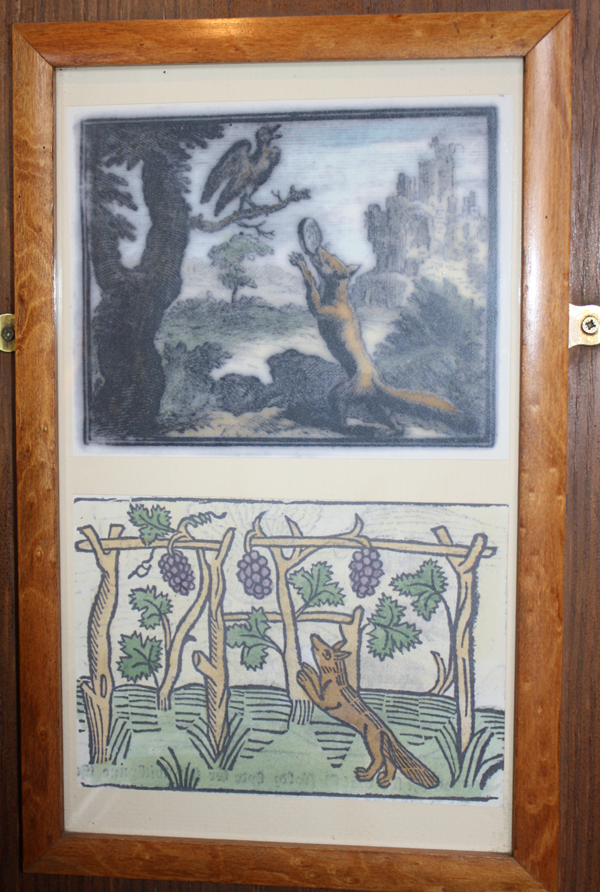
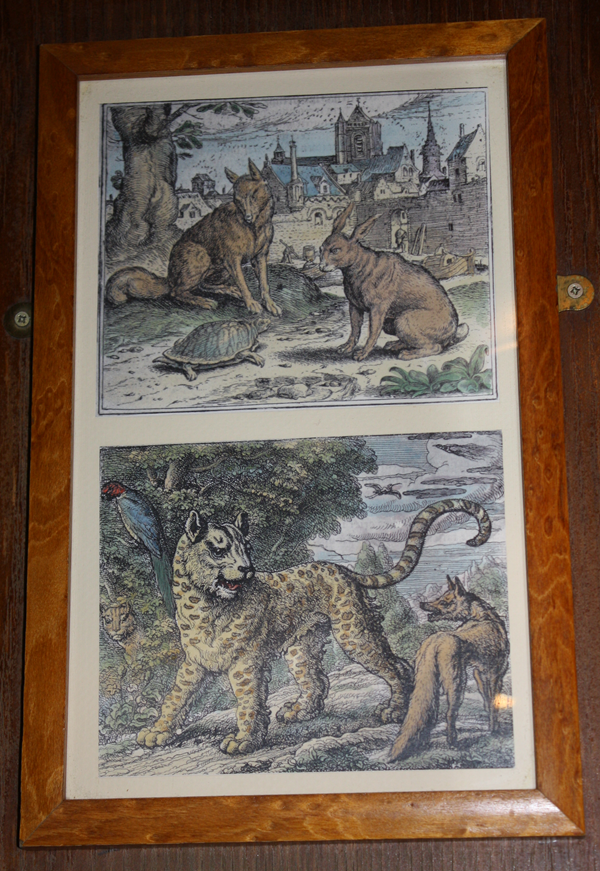
A framed drawing and text about Denmark Hill.
The text reads: Denmark Hill was the high Street of the old village od Camberwell. In the 17th century a house was built by sir Christopher Wren for Prince George of Demark (the Consort of Queen Ann) on a site facing Coldharbour Lane, where Daneville and Selbourne Roads are now situated.
In the late 18th century John Perkins, a partner in the famous Southwark brewery of Barclay and Perkins, lived there. His close friend Doctor Johnson was a frequent visitor, and for years after there was a path in the grounds named Dr. Johnson’s Walk.
Later still the house Denmark Hill Grammar School
Sir Claude’s family came from France as refugees in 1717. His residence at Denmark Hill is recalled in both De Crespigney and Champion Road.
He entertained George IV in the grounds of his estate and received a Baronetcy. His residence was champion Lodge (above). Sir Claude’s wife, born Mary Clarke, became a bride at the age of 16, and gained a literary reputation, publishing Letter to an Only Son and a novel, The Pavilion.
Framed drawings and text about John Ruskin.
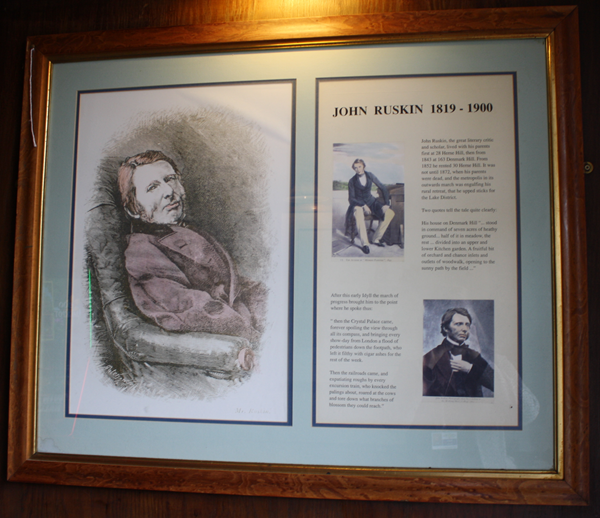
The text reads: John Ruskin, the great literary critic and scholar, lived with his parents first at 28 Herne Hill, then from 1843 at 163 Denmark Hill. From 1852 he rented 30 Herne hill. It was not until 1872, when his parents were dead, and the metropolis in its outwards march was engulfing his rural retreat, that he upped sticks for Lake District.
Two quotes tell the tale quite clearly:
His house on Denmark “…stood in command of seven acres of healthy ground… half of it in meadow, the rest…divided into an upper and lower kitchen garden. A fruitful bit of orchard and chance inlets and outlets of woodwalk, opening to the sunny path by the field…”
After this early Idyll the march of progress brought him to the point where her spoke thus:
“Then the Crystal Palace came, forever spoiling the view through all its compass, and bringing every show-day from London a flood of pedestrians down the footpath, who left it filthy with cigar ashes for the rest of the week.
Then the railroads came, and expatiating roughs by every excursion train, who knocked the palings about, roared at the cows and tore down what branches of blossom they could reach”.
A framed passage from John Ruskin.
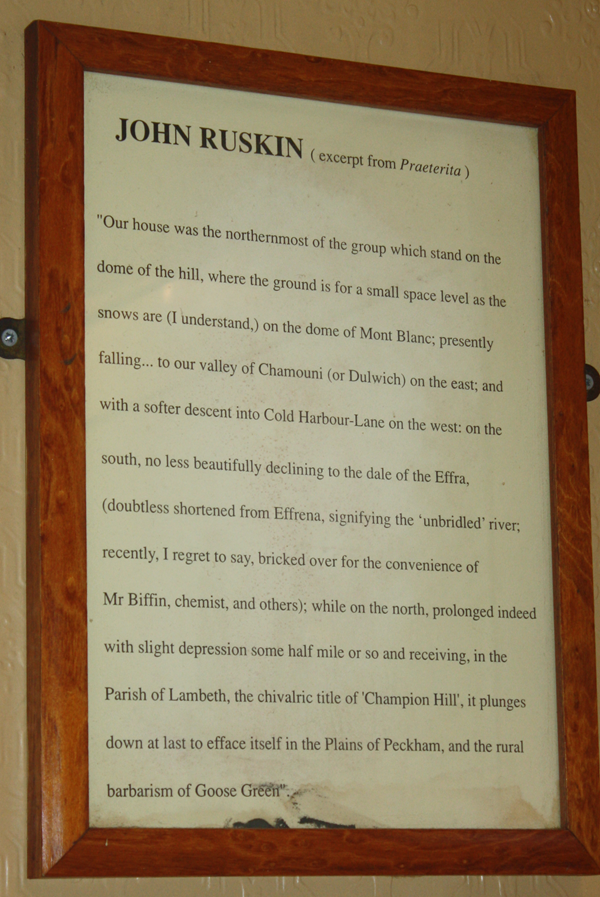
The text reads: (excerpt from Praeterita)
“Our house was the northernmost of the group which stand on the dome of the hill, where the ground is for a small space level as the snows are (I understand,) on the dome of Mont Blanc; presently falling…to our valley of Chamouni (or Dulwich) on the east; and with a softer descent into Cold harbour- Lane on the west: on the south, no less beautifully declining to the dale of the Effra. (doubtless shortened from Effrena, signifying the “unbridled” river; recently, I regret to say, bricked over for the convenience of Mr Biffin, chemist, and others); while on the north, prolonged indeed with slight depression some half mile or so and receiving, in the Parish of Lambeth, the chivalric title of ‘Champion Hill’, it plunges down at last to efface itself in the Plains of Peckham, and the rural barbarism of goose Green.”
A framed passage from John Ruskin.
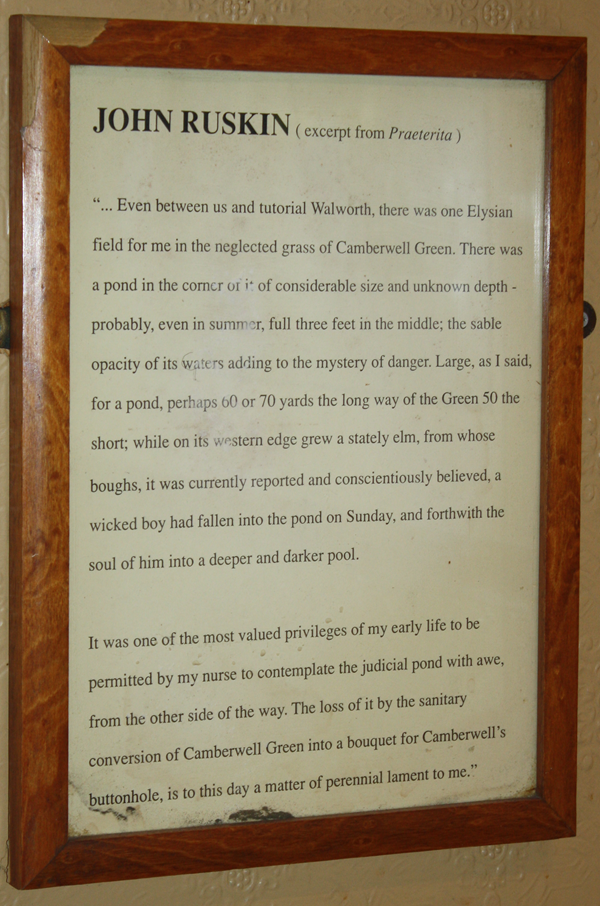
The text reads: (excerpt from Praeterita)
“…Even between us and tutorial Walworth, there was one Elysian field for me in the neglected grass of Camberwell Green. There was a pond in the corner of it of considerable size and unknown depth- probably, even in summer, full three feet in the middle; the sable opacity of its waters adding to the mystery of danger. Large, as I said, for a pond, perhaps 60 or 70 yards the long way of the Green 50 the short; while on its western edge grew a stately elm, from whose boughs, it was currently reported and conscientiously believed, wicked boy had fallen into the pond on Sunday, and forthwith the soul of him into a deeper and darker pool.
It was one of the most valued privileges of my early life to be permitted by my nurse to contemplate the judicial pond with awe, from the other side of the way. The loss of it by the sanitary conversion of Camberwell Green into a bouquet for Camberwell’s buttonhole, is to this day a matter of perennial lament to me.”
A framed piece of text about John Ruskin’s visitors to Denmark Hill.
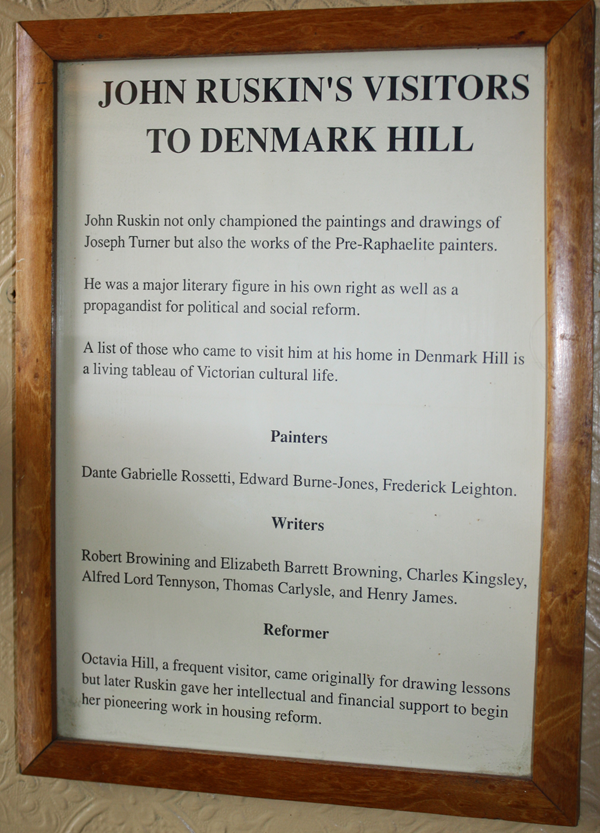
The text reads: John Ruskin not only championed the paintings and drawings of Joseph Turner but also the works of the Pre-Raphaelite painters.
He was a major literary figure in his own right as well as propagandist for political and social reform.
A list of those who came to visit him at his home I Denmark is a living tableau of Victorian Cultural life.
Painters
Dante Gabrielle Rossetti, Edward Burne-Jones, Frederick Leighton.
Writers
Robert Browning and Elizabeth Barrett Browning, Charles Kingsley, Alfred Lard Tannyson, Thomas Carlysle, and Henry James.
Reformer
Octavia Hill, a frequent visitor, came originally for drawing lessons but later Ruskin gave her intellectual and financial support to begin her pioneering work in housing reform.
A framed print and text about John Ruskin.
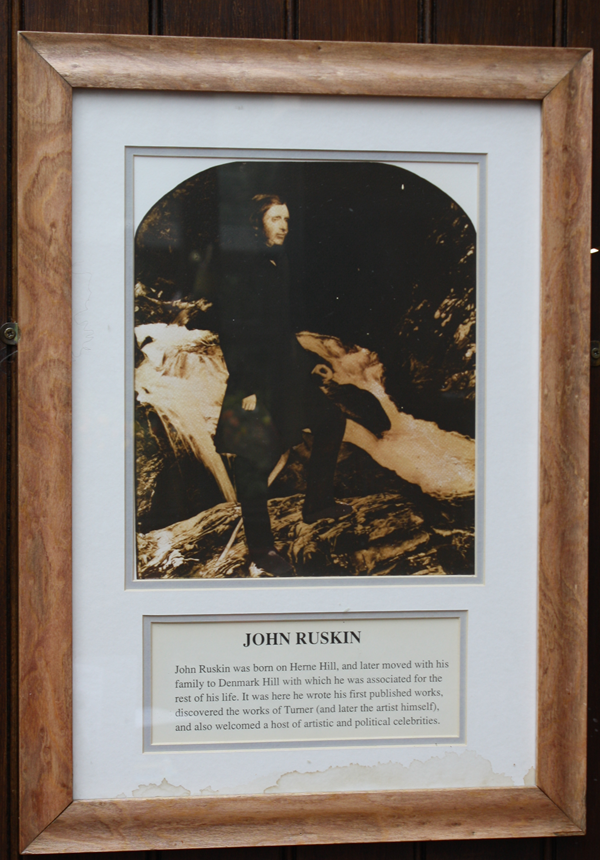
The text reads: John Ruskin was born on Herne Hill, and later moved with his family to Denmark Hill with which he was associated for the rest of his life. It was here he wrote his first published works, discovered the works of Turner (and later the artist himself), and also welcomed a host of artistic and political celebrities.
Framed drawings and text about Dr. Lettsom of Grove Hill.
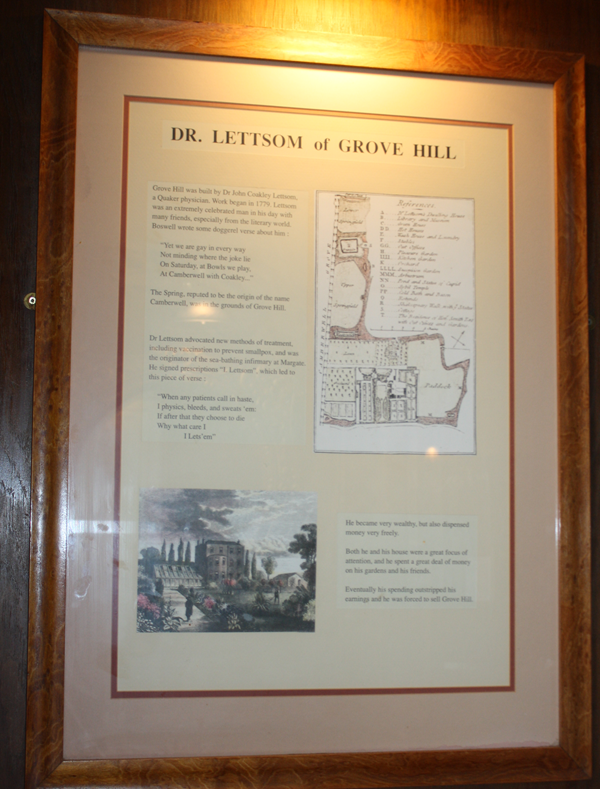
The text reads: Grove Hill was built by Dr John Coakley Lettsom, a Quaker physician. Work began in 1779. Lettsom was an extremely celebrated man in his day with many friends, especially from the literary world. Boswell wrote some doggerel verse about him:
“yet we are gay in every way
Not minding where the joke lie
On Saturday, at bowls we play,
At Camberwell with Cloakley…”
The Spring, reputed to be the origin of the name Camberwell, was in the grounds of Grove Hill.
Dr Lettsom advocated new methods of treatment, including vaccination to prevent smallpox, and was the originator of the sea-bathing infirmary at Margate. He signed prescriptions “I, Lettsom”, which led to this piece of verse:
“When any patients call in haste,
I physics, bleeds, and sweats ‘em:
If after that they choose to die
Why what care I
I lets ’em”.
Framed photographs and text about Henry Maudsley.
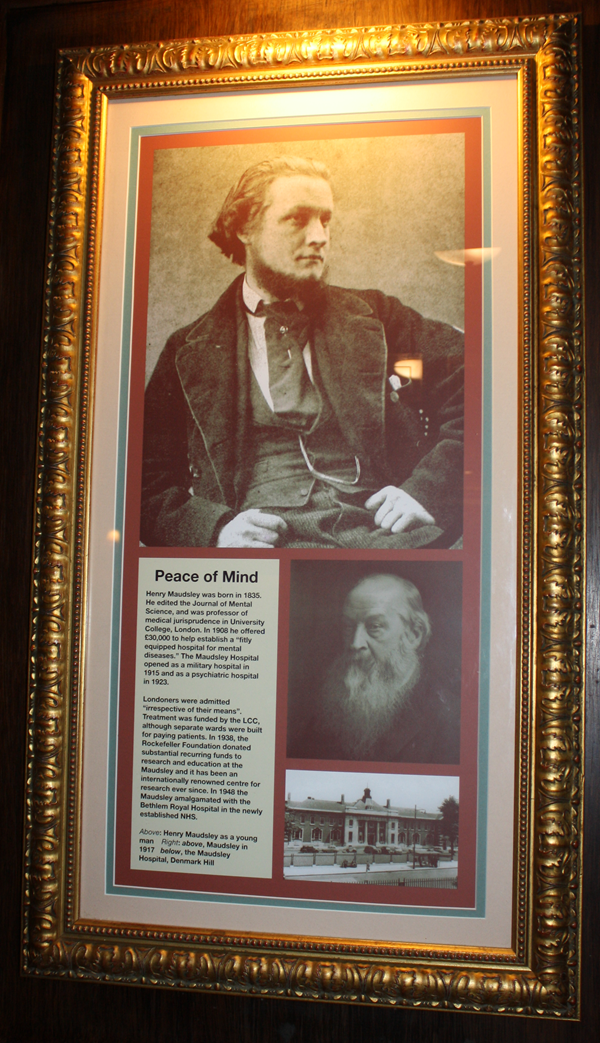
The text reads: Henry Maudsley was born in 1825. He edited the journal of mental Science, and was professor of medical jurisprudence in University College, London. In 1908 he offered £30,000 to help establish a “fitly equipped hospital for mental diseases”. The Maudsley Hospital opened as a military hospital in 1915 and as a Psychiatric hospital in 1923.
Londoners were admitted “irrespective of their means”. Treatment was funded by the LCC, although separate wards were built for paying patients. In 1938, the Rockefeller Foundation donated substantial recurring funds to research and education at the Maudsley and it has been an internationally renowned centre for research ever since. In 1945 the Maudsley amalgamated with the Bethlem Royal Hospital in the newly established NHS.
Above: Henry Maudsley as a young man
Right: above, Maudsley in 1917 below, The Maudsley Hospital, Denmark Hill.
A piece of text about the Maudsley Hospital.
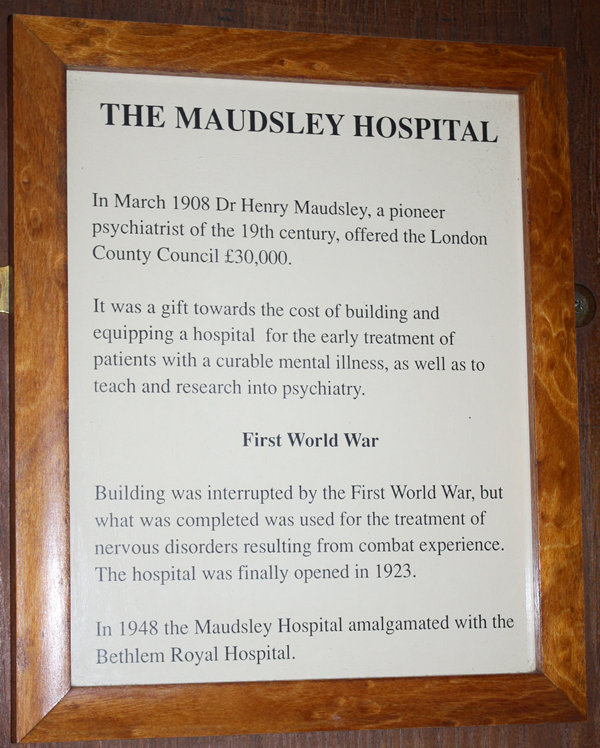
The text reads: In March 1908 Dr Henry Maudsley, a pioneer of the 19th century, offered the London County Council £30,000.
It was a gift towards the cost of building and equipping a hospital for the early treatment of patients with a curable mental illness, as well as to teach and research into psychiatry, as well as to teach and research into Psychiatry.
Building was interrupted by the First World war, but what was completed was used for the treatment of nervous disorders resulting from combat experience. The hospital was finally opened in 1923.
In 1948 the Maudsley Hospital amalgamated with the Bethlem Royal Hospital.
A framed drawing and text about the General Booth memorial Training College.
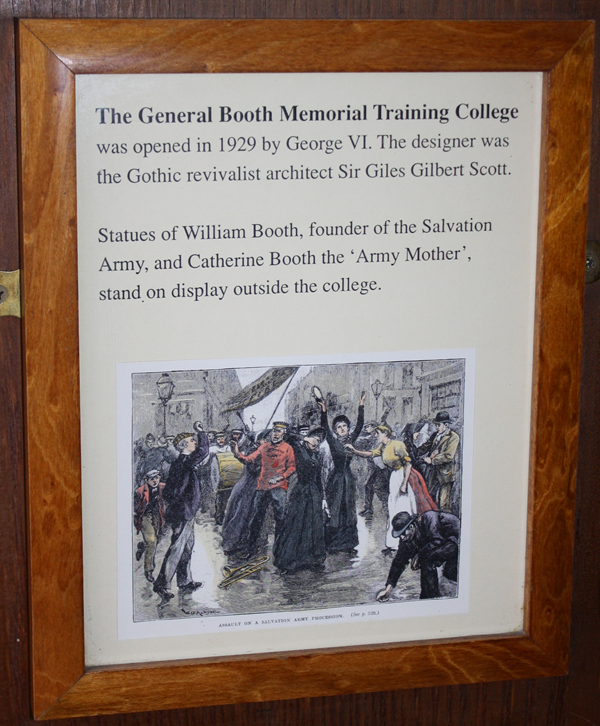
The text reads: The General Booth Memorial Training College was opened in 19129 by George VI. The designer was the Gothic revivalist architect Sir Giles Scott.
Statues of William Booth, founder of the Salvation Army, and Catherine booth the ‘Army Mother’, stand on display outside the college.
Framed photographs and text about Sir Henry Bessemer and Sidney Gilchrist Thomas.
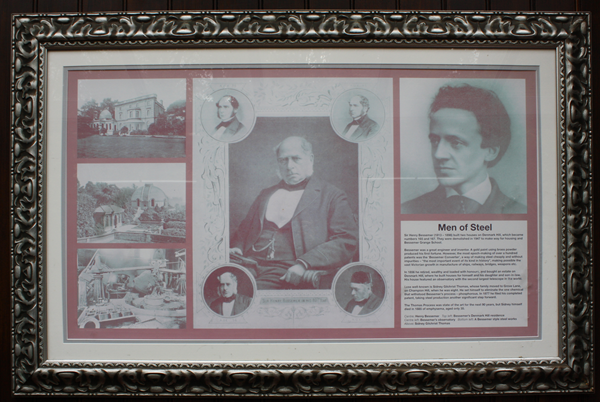
The text reads: Sir Henry Bessemer (1813-1898) built two houses on Denmark hill, which became number 165 and 167. They were demolished in 1947 to make way for housing Bessemer Grange School.
Bessemer was a great engineer and inventor. A gold paint using brass powder produced his first fortune. However, the most epoch-making of over a hundred patents was the ‘Bessemer Converter’, a way making steel cheaply and without impurities- “the most important event of its kind in history”, making possible the vast Victorian growth in manufacture of ships, railways, bridges weapons etc.
In 1856 he retired, wealthy and loaded with honours, and bought an estate on Denmark hill, where he built houses for himself and his daughter and son-in-law. His house featured an observatory with second largest telescope in the world.
Less well-known is Sidney Gilchrist Thomas, whose family moved to Grove Lane, on Champion Hill, When he was eight. He set himself to eliminate the one chemical that withstood Bessemer’s process- Phosphorous. In 1877 he filed his completed patent, taking steel production another significant step forward.
The Thomas Process was state of the art for the next 90 years, but Sidney himself died 1885 of emphysema, aged only 35.
Centre: Henry Bessemer
Top left: Bessemer’s Denmark Hill residence
Centre lefty: Bessemer’s observatory
Bottom left: A Bessemer Steel works
Above: Sidney Gilchrist Thomas.
A framed photograph of the interior of Henry Bessemer’s house, Denmark Hill, c.1890.
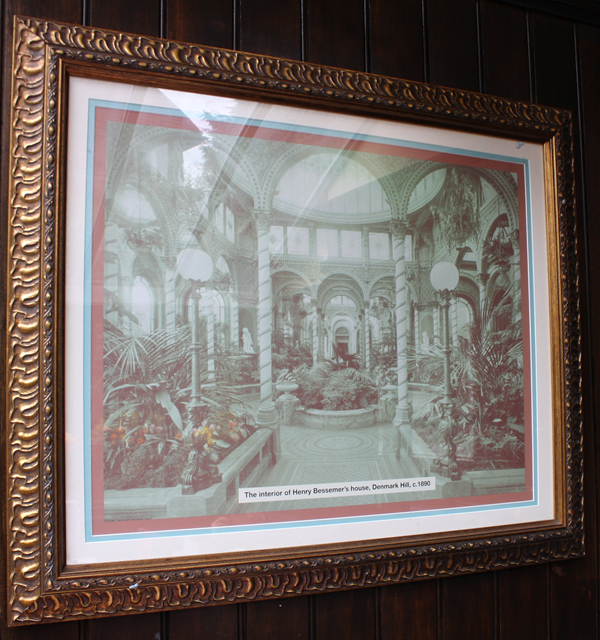
Framed prints and text about Sir Thomas Wyatt and Dr. Samuel Johnson.
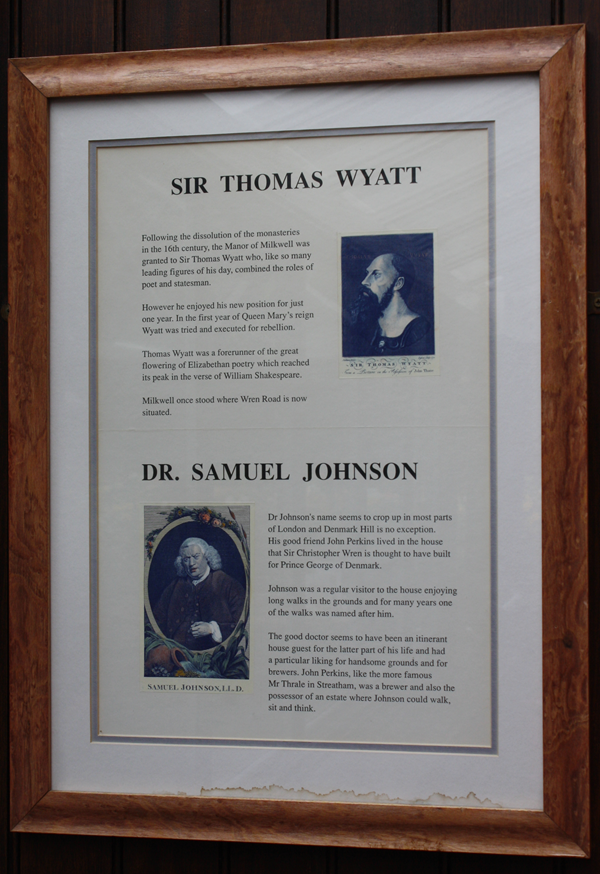
The text reads: Sir Thomas Wyatt
Following the dissolution of the monasteries in the 16th century, the Manor of Milkwell was granted to Sir Thomas Wyatt who, like so many leading figures of his day, combined the roles of poet and statesman.
However he enjoyed his new position for just one year. In the first year of queen Mary’s reign Wyatt was tried and executed for rebellion.
Thomas Wyatt was forerunner of the great flowering of Elizabethan poetry which reached its peak in the verse of William Shakespeare.
Milkwell once stood where Wren Road is now situated.
Dr. Samuel Johnson
Dr Johnson’s name seems to crop up in most parts of London and Denmark Hill is no exception. His good friend John Perkins lived in the house that Sir Christopher Wren is thought to have built for prince George of Denmark.
Johnson was a regular visitor to the house enjoying long walks in the grounds and for many years one of the walks was named after him.
The good doctor seems to have been an itinerant house guest for the latter part of his life and had a particular liking for handsome grounds and for brewers. John Perkins, like the more famous Mr Thrale in Streatham, was a brewer and also the possessor of an estate where Johnson could walk, sit and think.
Framed prints and text about Joseph Chamberlain and Felix Mendelssohn.
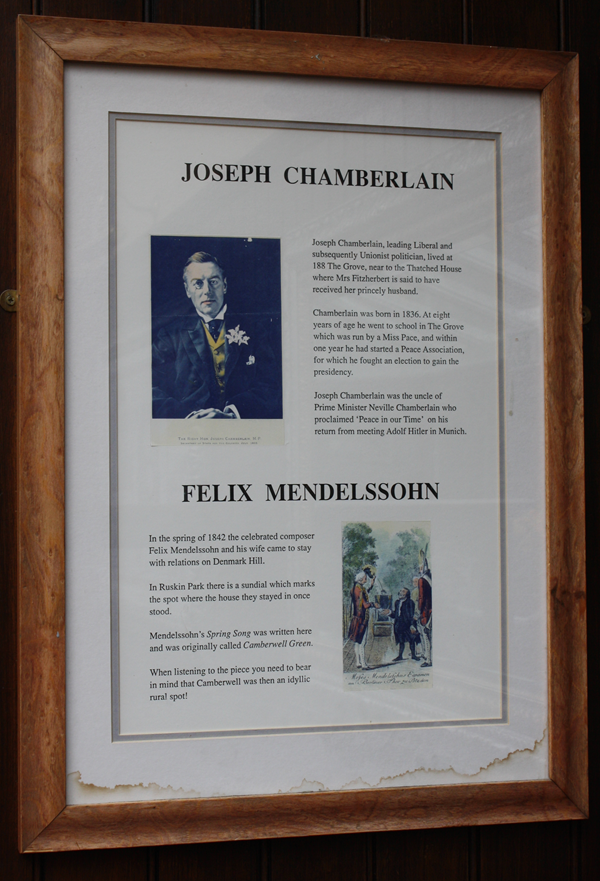
The text reads: Joseph Chamberlain
Joseph Chamberlain, leading Liberal and subsequently Unionist politician, lived at 188 The grove, near Thatched House where Mrs Fitzherbert is said to have received her princely husband.
Chamberlain was born in 1836. At eight years of age he went to school in The Grove which was run by Miss Pace, and within one year he had started a Peace Association, for which he fought an election to gain presidency.
Joseph Chamberlain was the uncle of Prime Minister Neville Chamberlain who proclaimed ‘Peace in our Time’ on his return from meeting Adolf Hitler in Munich
Felix Mendelssohn
In the spring of 1842 the celebrated composer Felix Mendelssohn and his wife came to stay with relations on Denmark Hill.
In Ruskin Park there is a sundial which marks the spot where the house they stayed in once stood.
Mendelssohn’s Spring song was written here and was originally called Camberwell Green.
When listening to the piece you need to bear in mind Camberwell was then an idyllic rural spot!
Framed photographs and text about Sir Robert Hunter.
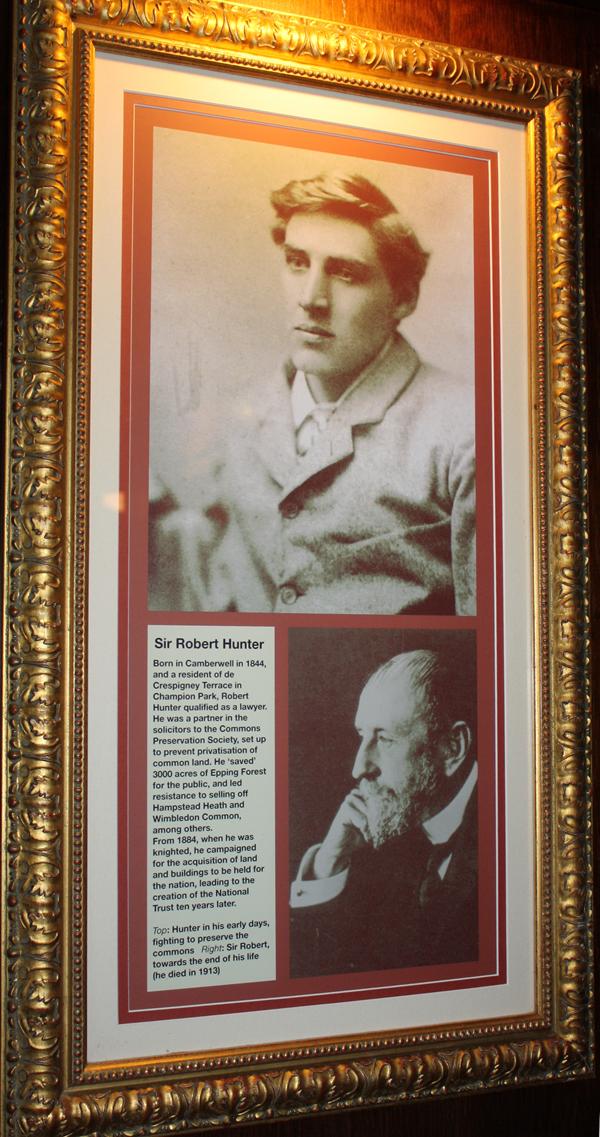
The text reads: Born in Camberwell in 1844, and a resident of de Crespigney Terrace in Champion Park, Robert Hunter qualified as a lawyer. He was a partner in the solicitors to the Commons Preservation Society, set up to prevent privatisation of common land. He ‘saved’ 3000 acres of Epping Forest for the public, and led resistance to selling of Hampstead Heath and Wimbledon common, among others.
From 1884, when he was knighted, he campaigned for the acquisition of land and building to be held for the nation, leading to the creation of the National Trust ten years later.
Top: Hunter in his early days, fighting to preserve the commons
Right: Sir Robert towards the end of his life (he died in 1913).
Framed drawing and text about Bowyer House.
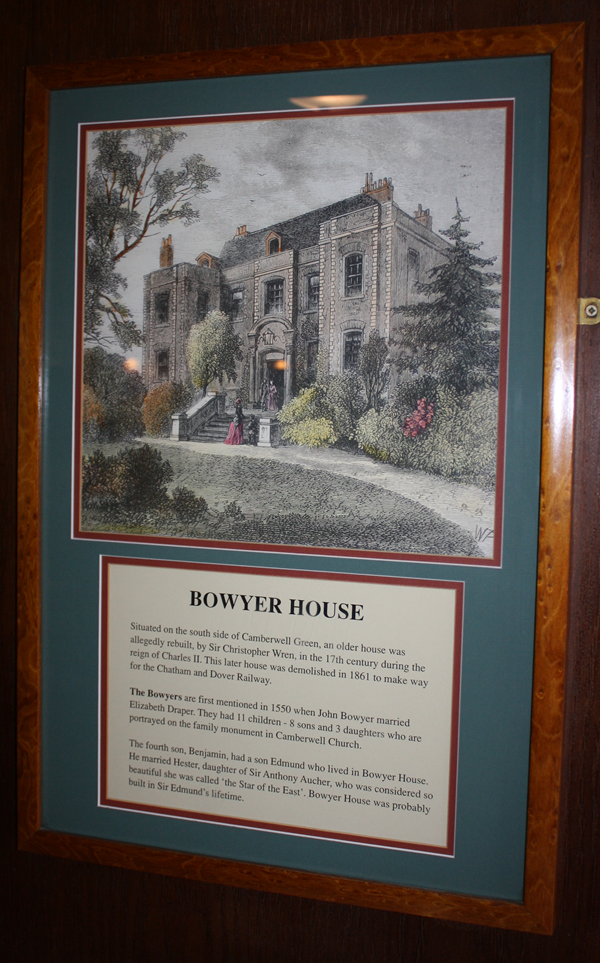
The text reads: Situated on the south side of Camberwell Green, an older house was allegedly rebuilt, by sir Christopher Wren, in the 17th century during the reign of Charles II. This later house was demolished 1861 to make way for the Chatham and Dover Railway.
The Bowyers are first mentioned in 1550 when John Bowyer married Elizabeth Draper. They had 11 children- 8 sons and 3 daughters who are portrayed on the family monument in Camberwell Church.
The fourth son, Benjamin, had a son Edmund who lived in Bowyer House. He married Hester, daughter of Sir Anthony Aucher, who was considered so beautiful she was called ‘the Star of the East’. Bowyer House was probably built in Sir Edmund’s lifetime
Framed drawings and text about the history of the area.
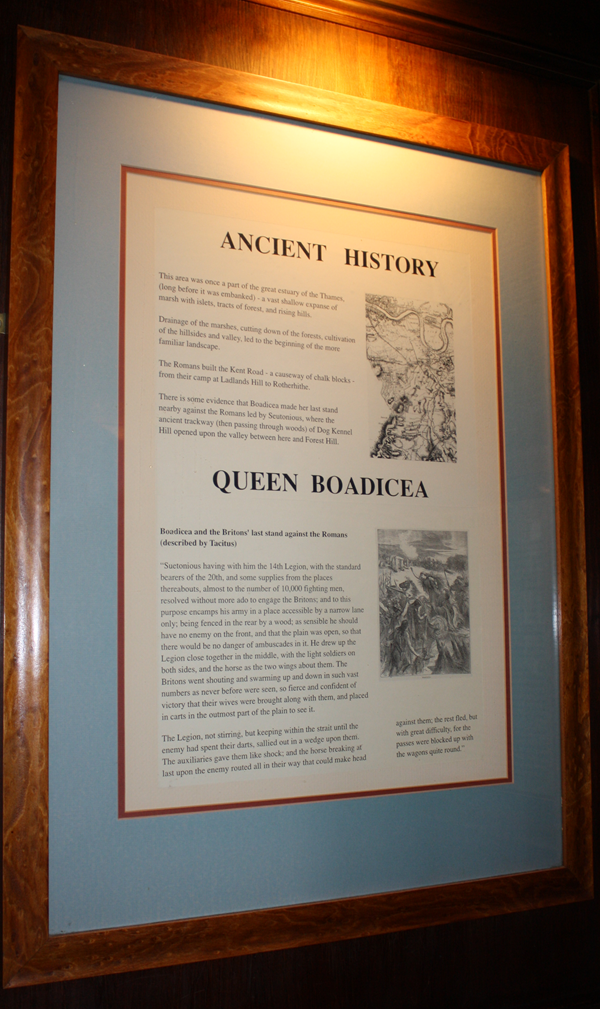
The text reads: Ancient History
This area was once part of the great estuary of the Thames, (long before it was embanked) - a vast shallow expanse of marsh with islets, tracts of forest, and rising hills.
Drainage of the marshes, cutting down of forests, cultivation of the hillsides and valley, led to the beginning of the more familiar landscape.
The Romans built the Kent Road – a causeway of chalk blocks- from their camp at Ladlands Hill to Rotherhithe.
There is some evidence that Boadicea made her last nearby against the Romans led by Seutonious, where the ancient trackway (then passing through woods) of Dog Kennel Hill opened upon the valley between here and Forest Hill.
Queen Boadicea
Boadicea and the Britons’ last stand against the Romans
(described by Tacitus)
“Suetonious having with him the 14th Legion, with the standard bearers of the 20th, and some supplies from the places thereabouts, almost to the number of 10,000 fighting men, resolved without more ado to engage the Britons; and to this purpose encamps his army in a place accessible by a narrow lane only; being fenced in the rear by a wood; as sensible he should have no enemy on the front, and that the plain was open, so that there would be no danger of ambuscades in it. He drew up the Legion close together in the middle, with the light soldiers on both sides, and the horses as the two wings about them. The Britons went shouting and swarming up and down in such vast numbers as were never before seen, so fierce and confident of victory that their wives were brought along with them, and placed in carts in the outmost part of the plain to see it.
The Legion, not stirring, but keeping within the strait until the enemy had spent their darts, sailed out in a wedge upon them. The auxiliaries gave them like shock; and the horse breaking at last upon the enemy routed all in their way that could make head against then; the rest fled, but with great difficulty, for the passes were blocked up with the wagons quite round.”
A piece of text about medieval justice.
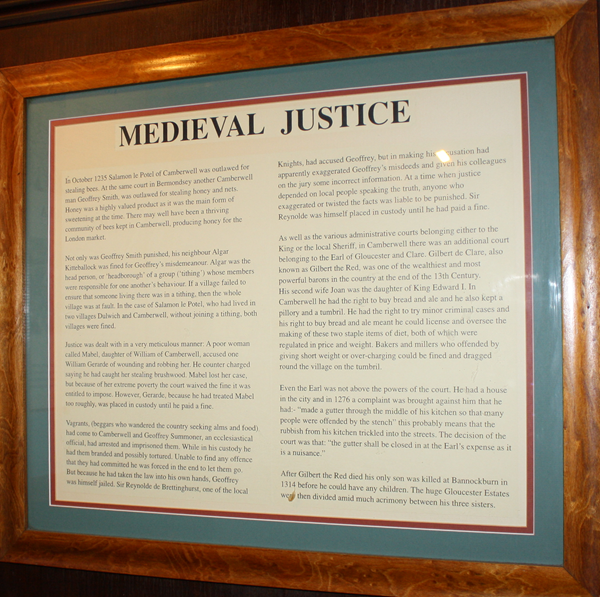
The text reads: In October 1235 Salamon le Potel of Camberwell was outlawed for stealing bees. At the same court in Bermondsey another Camberwell man Geoffrey Smith, was outlawed for stealing honey and nets. Honey was a highly valued product as it was the main form of sweetening at the time. There may well have been a thriving bees kept in Camberwell, producing honey for the London market.
Not only was Geoffrey Smith outlawed, his neighbour Algar Kitteballock was fined for Geoffrey’s misdemeanour. Algar was the head person, or ‘headborough’ of a group (‘tithing’) whose members were responsible for one another’s behaviour. If a village failed to ensure that someone living there was in tithing, then the whole village was at fault. In the case of Salamon le Potel, who had lived in two villages Dulwich and Camberwell, without joining a tithing, both villages were fined.
Justice was dealt with in a very a malicious manner: A poor woman called Mabel, daughter of William of Camberwell, accused one William Gerarde of wounding and robbing her. He counter charged saying he caught he stealing brushwood. Mabel lost her case, but because of her extreme poverty the court waived the fine it was entitled to impose. However, Gererde, because he treated Mabel too roughly, was placed in custody until he paid a fine.
Vagrants, (beggars who wandered the country seeking alms and food) had come to Camberwell and Geoffrey Summoner, an ecclesiastical officer, had arrested and imprisoned them. While in his custody he had them branded and possibly tortured. Unable to find any offence that they had committed he was forced in the end to let them go. But because he had taken the law into his own hands, Geoffrey was himself jailed. Sir Reynolde de Brettinghurst, one of the local knights, had accused Geoffrey, but in making his accusation had apparently exaggerated Geoffrey’s misdeeds and given his colleagues on the just one incorrect information. At a time when justice depended on local people seeking truth, anyone who exaggerated or twisted facts was liable to be punished. Sir Reynolde was himself placed in custody until he had paid a fine.
As well as the various administrative courts belonging either to the king or local sheriff, in Camberwell there was an additional court belonging to the Earl of Gloucester and Clare. Gilbert de Clare, also known as Gilbert de Red, was one of the wealthiest and most powerful barons in the country at the end of the 13th century. His second wife Joan was the daughter of King Edward I. In Camberwell he had the right to buy bread and ale and he also kept a pillory and tumbril. He had the right to try minor criminal cases and his right to buy bread and ale meant he could license and oversee the making of these two staple items of diet, both of which were regulated in price and weight. Bakers and millers who offended by giving short weight or over charging could be fined and dragged round the village on the tumbril.
Even the Earl was not above the power of the court. He had a house in the city and in 1276 a complaint was brought against him that he had: - “made a gutter through the middle of kitchen so that many people were offended by the stench” this probably means that the rubbish from his kitchen trickled into the streets. The decision of the court was that: “the gutter shall be closed in at the Earl’s expense as it is a nuisance.”
After Gilbert the Red died his only was killed at Bannockburn in 1314 before he could have any children. The huge Gloucester Estates were then divided amid acrimony between his three sisters.
Framed photographs of Denmark Hill c.1905.
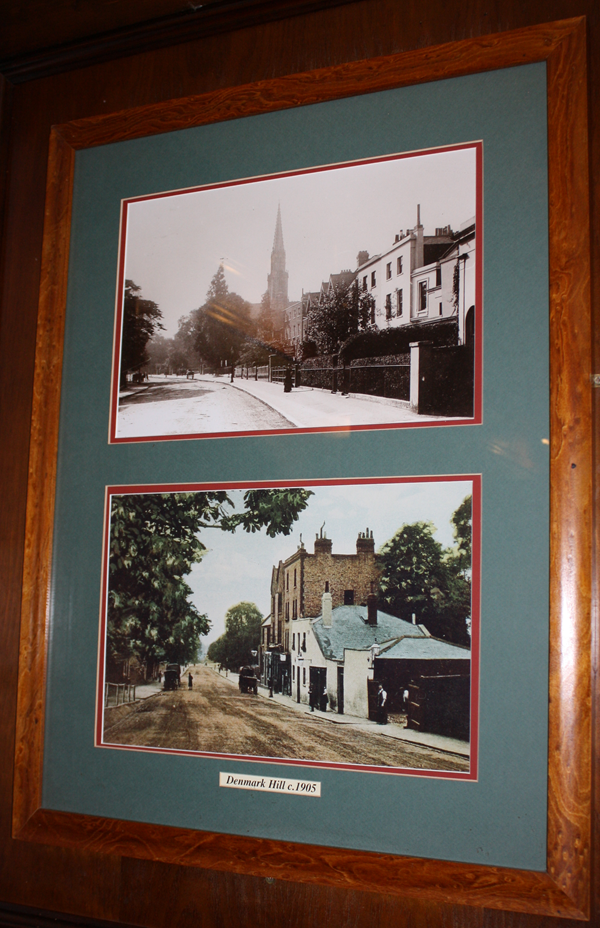
Framed photographs of The Fox on the Hill c.1908.
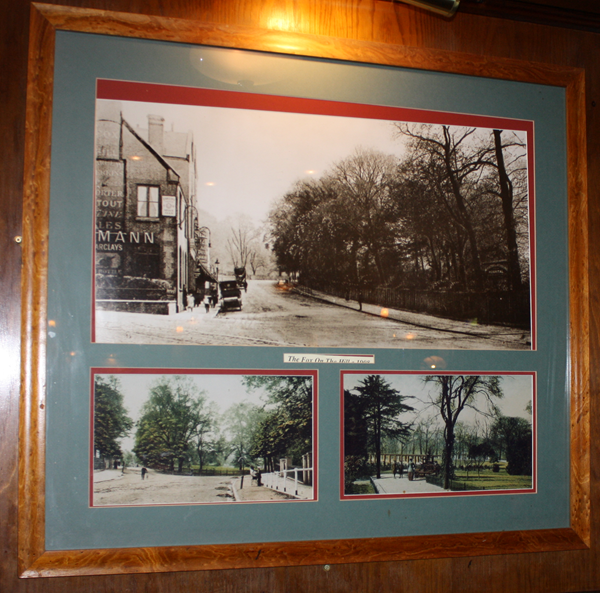
A framed photograph of Camberwell Green c.1914.
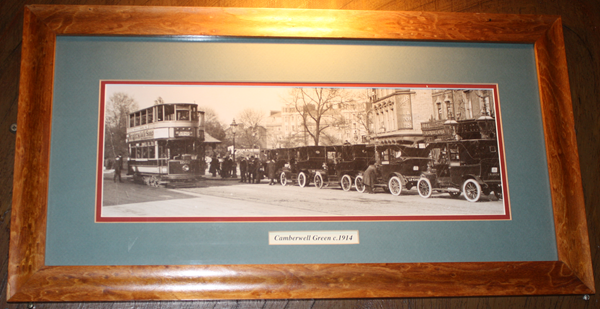
A framed photograph of Camberwell Green c.1911.
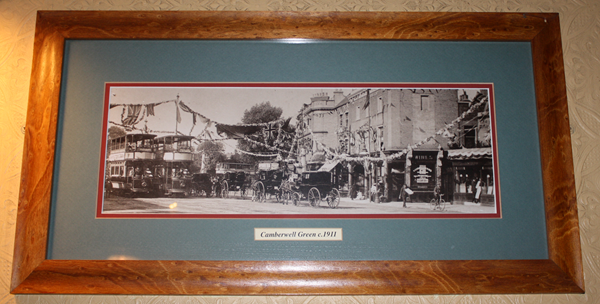
A framed photograph of H.M. The King, passing Camberwell Gate c.1909.
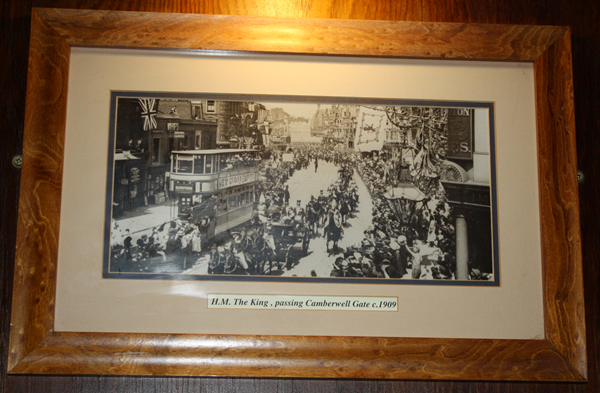
A framed photograph of Camberwell Green.
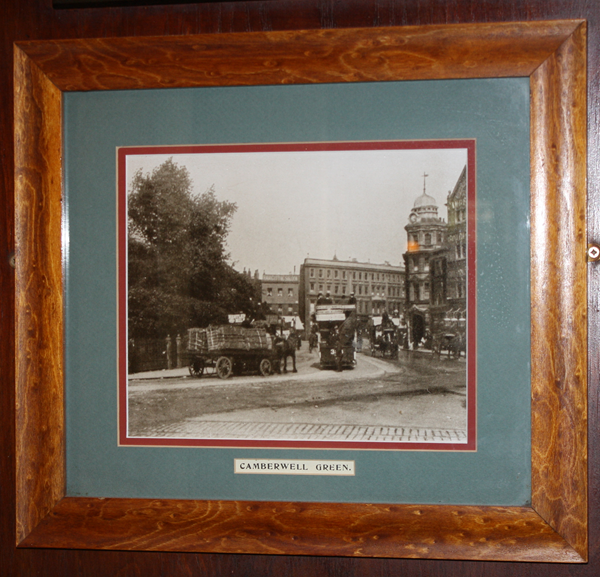
A framed photograph of South London Art Gallery, and L.C.C. Camberwell School of Arts and Crafts.
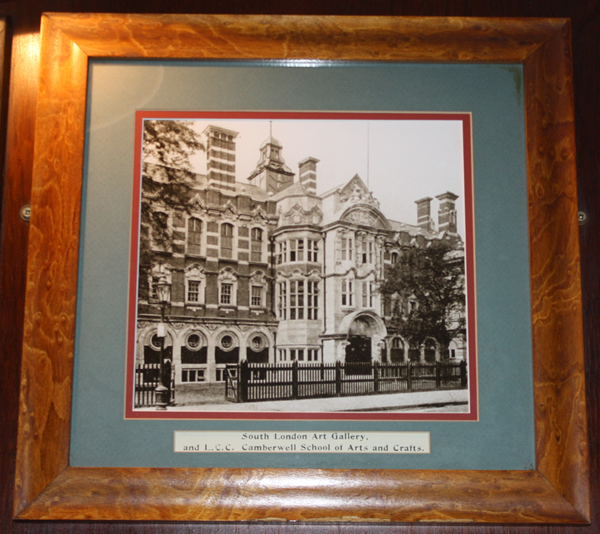
Framed photographs of The Art Gallery, The Town Hall, Camberwell Green and Upper Tulse Hill.
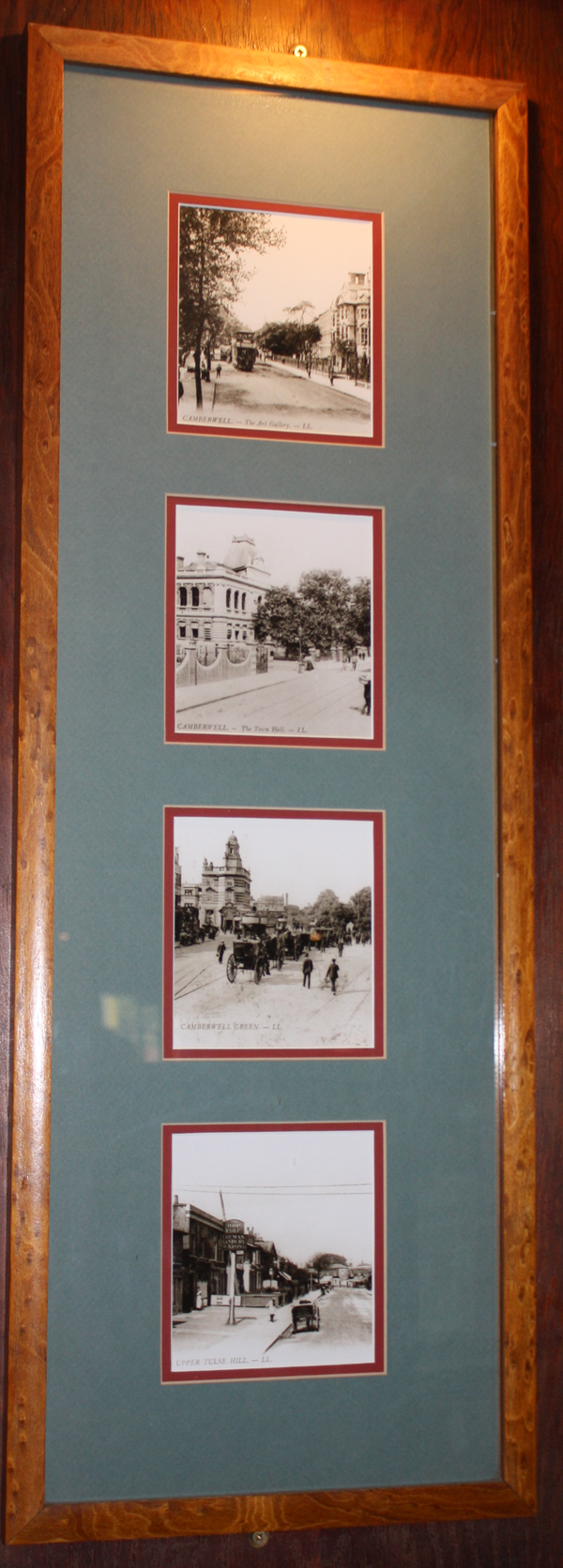
Framed photographs of the Central Public Library, Camberwell and St Matthew’s Church.
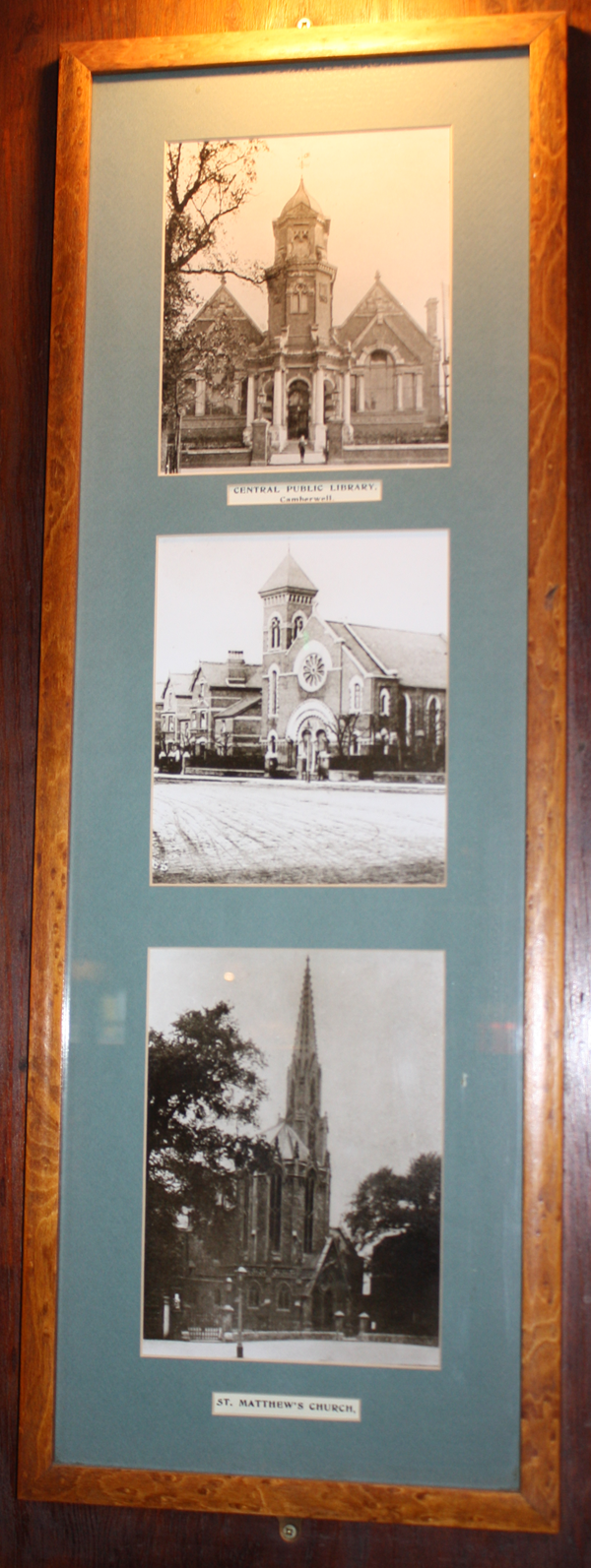
Framed photographs of St. Giles’ Church, Camberwell and Church Passage, Camberwell.

A framed photograph of Church Street, Camberwell.
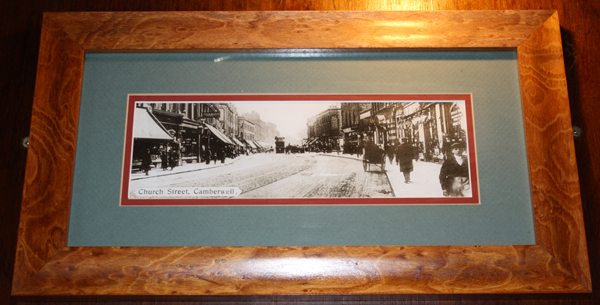
A framed photograph of Camberwell c.1909.
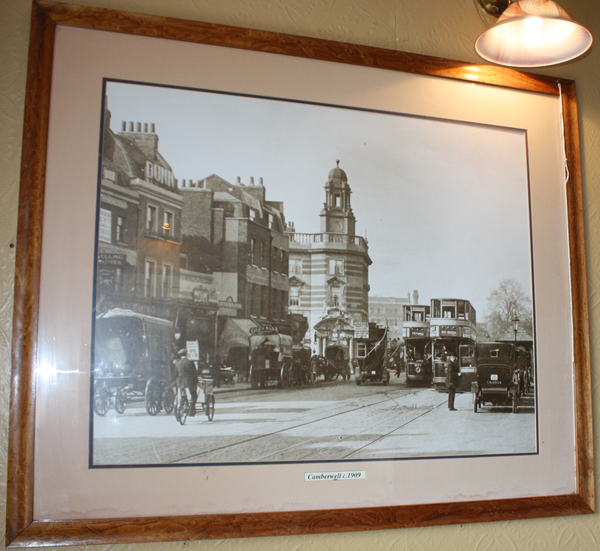
External photograph of the building – main entrance.
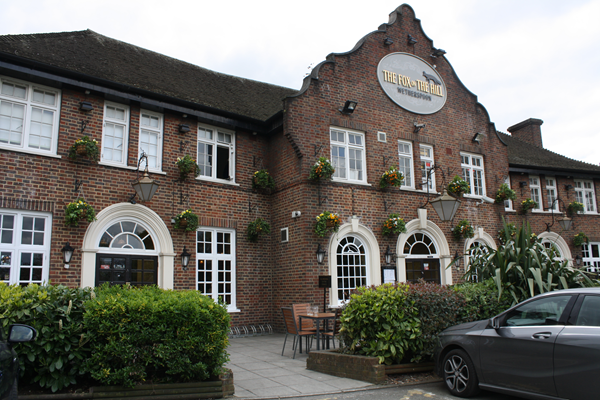
If you have information on the history of this pub, then we’d like you to share it with us. Please e-mail all information to: pubhistories@jdwetherspoon.co.uk